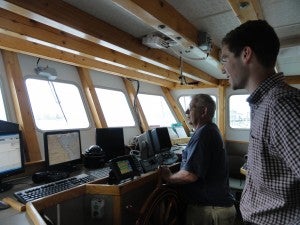Building Resilient New England Fisheries in the Face of Climate Change

Alex Koeberle and Scituate Fisherman Frank Mirarchi
By: Alex Koeberle and Jake Kritzer
Following the hottest summer ever on record, the Atlantic coast was rocked recently by super storm Sandy, both stark reminders that climate change is increasing the frequency and severity of extreme weather events. This year had already seen effects of climate change take on a more prominent place in marine conservation debates. In July, renowned Australian ecologist Dr. Roger Bradbury argued that the fate of coral reefs is essentially sealed due to warming waters, rising seas, acidification and extreme weather (although other prominent voices were quick to counter such doomsday predictions). Closer to home, an effort to restore Atlantic salmon to the Connecticut River was ended after nearly a half-century, in part because changing ocean currents, temperature regimes and plankton production might be impairing the ability of salmon to survive at sea and migrate back to spawn.
It is not only salmon that are contending with effects of climate change in New England. The region is seeing sea levels rising faster than many other places around the globe, which threatens to drown salt marshes already struggling with excessive nutrient loads. Marshes help buffer coastal areas against storm surge, and provide vital nursery and feeding grounds for many important fish species. Ocean waters are not only rising but warming as well, one consequence of which has been a dramatic shift in the distribution of cod north of the primary fishing grounds in the western Gulf of Maine. Also, rainfall patterns are becoming increasingly erratic, altering salinity profiles and plankton production, which hampers productivity of species throughout the food web.
Slowing and even reversing effects of climate change will require serious efforts to curb greenhouse gas emissions. Most of those efforts will be on the national and international level, beyond the scope of regional stakeholders and policymakers. Fishermen can, of course, contribute to CO2 reductions by adopting fishing practices that are more fuel efficient. Fuel consumption has been decreasing in recent years in response to flexibility offered by management reforms, which has also increased profitability of the fleet. But there are also important steps to be taken by fishermen, fishing communities and fishery managers in the region to increase resilience of the ecosystem and fishing industry:
Fishermen
- Keep pace with change. Fishermen are among the best and most practiced naturalists on the water, with lifetimes of observations and experience with changing ecosystems. As the pace of ecosystem change quickens, so too must fishermen become even keener observers and recorders of that change in order to most effectively adapt fishing strategies.
- Contribute to science. Scientists struggle as much as any other stakeholders to track and respond to changes in the ecosystem. Fishermen should share observations, offer vessels as survey platforms, and otherwise engage more actively with scientists to better understand an evolving ecosystem.
- Diversification. As once common species decline in abundance or move to other areas, while formerly rare species increase in abundance and move in from other areas, fishermen will need to diversify the range of species they can effectively harvest through the quota and permits they hold, and responsive gear modification.
- Creative marketing. Maximizing value of each pound landed and opening new avenues for selling catch will allow fishermen to best utilize whatever abundance and diversity a changing ecosystem provides.
Fishing communities
- Ecological infrastructure. Although most fishery management decisions are made by state and federal entities, municipalities and local civic, industry and environmental organizations have considerable power to shape nearshore waters. Protection of salt marshes (including space for upland migration), restoration of seagrass and shellfish beds, increasing ability for fish passage up rivers, and improving water quality by management of stormwater, fertilizer use and pollution will all enhance ecological productivity and resilience.
- Economic infrastructure. Fishermen need adequate space and facilities for docking, storage, repairs, and landing fish. Creating and protecting working waterfronts will provide that needed infrastructure. Furthermore, creating and promoting community supported fisheries, farmers markets, and others avenues for sale to high value markets will help maximize revenue.
- Supporting diversification. In addition to fishermen’s own quota and permit holdings, quota and permit banks can provide access to a wider range of resources in a changing environment. Local sources of funding or other support for gear innovation can also help fishermen become more diversified and responsive.
Fishery managers
- Scientific innovations. Assumptions of constant dynamics underlying most stock assessment models are becoming increasingly invalid. Managers need to call for new models that account for changing conditions (climate, oceanography, habitat) and species interactions (predation, competition) so that assessment and management strategies are tuned as closely as possible to what is happening in the ocean.
- Adaptive management. Management strategies that make sense today might not make sense in the near future. For example, if warming waters cause fish in a given area to spawn earlier or later, then the timing of current spawning closures might become misaligned from the actual timing of spawning down the track. Managers need to create systems to track and respond to these sorts of changes.
- Bracing for change. Diverse and healthy habitats, including habitat mosaics, biodiversity and intact food webs, and complete age and size structure of exploited species are critical to maximizing productivity and resilience. Protected areas are an effective tool for achieving all of these attributes, if designed strategically.
Responding to climate change will require actions by all stakeholders in the realms of science, business planning and marketing, fishing behavior, and coastal ecosystem protection. Only through a multi-faceted approach will we ensure the continued productivity and vitality of our region’s fisheries.
Alex Koeberle is a senior at Cornell University majoring in Natural Resources, and was an intern with Dr. Jake Kritzer in the EDF Ocean Program during the summer of 2012. Jake is EDF’s Director of Spatial Initiatives, and Vice Chair of the New England Fishery Management Council’s Scientific and Statistical Committee and the Atlantic State Marine Fisheries Commission’s Habitat Committee.










